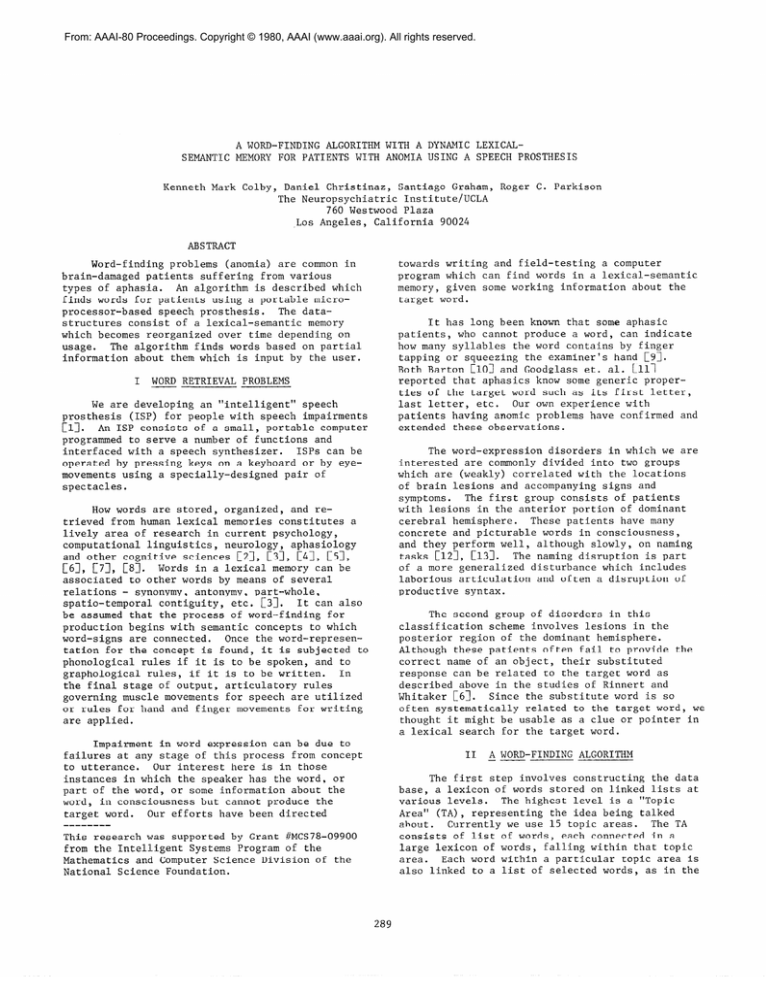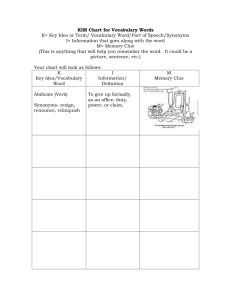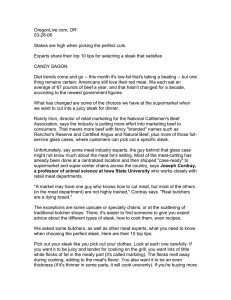
From: AAAI-80 Proceedings. Copyright © 1980, AAAI (www.aaai.org). All rights reserved.
SEMANTIC
Kenneth
Mark
A WORD-FINDING
ALGORITHM WITH A DYNAMIC LEXICALMEMORY FOR PATIENTS WITH ANOMIA USING A SPEECH PROSTHESIS
Colby,
Daniel Christinaz, Santiago Graham,
The Neuropsychiatric
Institute/UCLA
760 Westwood Plaza
Los Angeles, California 90024
Roger
C. Parkison
ABSTRACT
Word-finding
problems (anomia) are common in
brain-damaged
patients suffering from various
types of aphasia.
An algorithm is described which
finds words for patients using a portable microprocessor-based
speech prosthesis.
The datastructures consist of a lexical-semantic
memory
which becomes reorganized over time depending on
usage.
The algorithm finds words based on partial
information about them which is input by the user.
I
WORD
RETRIEVAL
towards writing and field-testing
a computer
program which can find words in a lexical-semantic
memory, given some working information about the
target word.
It has long been known that some aphasic
patients, who cannot produce a word, can indicate
how many syllables the word contains by finger
tapping or squeezing the examiner's hand [9].
Both Barton [lo] and Goodglass et. al. Lll]
reported that aphasics know some generic properties of the target word such as its first letter,
last letter, etc.
Our own experience with
patients having anemic problems have confirmed and
extended these observations.
PROBLEMS
We are developing an "intelligent"
speech
prosthesis
(ISP) for people with speech impairments
Cll. An ISP consists of a small, portable computer
programmed to serve a number of functions and
interfaced with a speech synthesizer.
ISPs can be
operated by pressing keys on a keyboard or by eyemovements using a specially-designed
pair of
spectacles.
The word-expression
disorders in which we are
interested are commonly divided into two groups
which are (weakly) correlated with the locations
of brain lesions and accompanying
signs and
symptoms.
The first group consists of patients
with lesions in the anterior portion of dominant
cerebral hemisphere.
These patients have many
concrete and picturable words in consciousness,
and they perform well, although slowly, on naming
The naming disruption is part
tasks [12], [13].
of a more generalized disturbance which includes
laborious articulation
and often a disruption of
productive syntax.
How words are stored, organized, and retrieved from human lexical memories constitutes a
lively area of research in current psychology,
computational
linguistics,
neurology, aphasiology
and other cognitive sciences [2], [3], [4], [5],
C61,1171, 181. Words in a lexical memory can be
associated to other words by means of several
relations - synonymy, antonymy, part-whole,
spatio-temporal
contiguity, etc. [33.
It can also
be assumed that the process of word-finding
for
production begins with semantic concepts to which
word-signs
are connected.
Once the word-representation for the concept is found, it is subjected to
phonological
rules if it is to be spoken, and to
graphological
rules, if it is to be written.
In
the final stage of output, articulatory
rules
governing muscle movements for speech are utilized
or rules for hand and finger movements for writing
are applied.
The second group of disorders in this
classification
scheme involves lesions in the
posterior region of the dominant hemisphere.
Although these patients often fail to provide the
correct name of an object, their substituted
response can be related to the target word as
described above in the studies of Rinnert and
Whitaker [6].
Since the substitute word is so
often systematically
related to the target word, we
thought it might be usable as a clue or pointer in
a lexical search for the target word.
Impairment in word expression can be due to
failures at any stage of this process from concept
to utterance.
Our interest here is in those
instances in which the speaker has the word, or
part of the word, or some information about the
but cannot produce the
word, in consciousness
target word.
Our efforts have been directed
-_------
II
A WORD-FINDING
---
ALGORITHM
The first step involves constructing
the data
base, a lexicon of words stored on linked lists at
The highest level is a "Topic
various levels.
the idea being talked
Area" (TA), representing
Currently we use 15 topic areas.
ahout.
The TA
consists of list of words, each connected in a
large lexicon of words, falling within that topic
Each word within a particular topic area is
area.
also linked to a list of selected words, as in the
This research was supported by Grant #MCS78-09900
from the Intelligent Systems Program of the
Mathematics
and Computer Science Division of the
National Science Foundation.
289
following
example:
(BODY
(ACHE (HEAD HURT PAIN STOMACH)
( ANKLE (FOOT
LEG) )
(WOUND
(BLOOD
CUT
HURT
Assuming that each slot in the pattern is
correct and not null, the program first finds a
short list of numbered candidate target words
(zero to a maximum of 20 words) meeting the input
The search will be
criteria of the clue pattern.
illustrated by cases.
)
Case (1). Suppose the target
The clue pattern might be:
) ) )
The organization
of the word lists changes
dynamically over time according to their usage,
will be described below.
(3)
(4)
(5)
CLUE = FOOD + S + K + A + meat.
The word meat is looked up on the FOOD list and
then a search is made on the list of words linked
with the word meat which begin with S and end with
K and have an A in between.
If steak were on the
list of words linked to meat, it would be displayed visually and auditorily as:
1.
Case (2). If steak were not found on the
meat list of FOOD, the "meat" part of the clue is
ignored and all words under FOOD beginning with
(S) , ending in (K), and with an (A) in between
are retrieved.
The word steak might appear in
this group and if so, the program will add it to
the meat list after the user signifies this is
Thus the lexical memory becomes
his target word.
automatically
reorganized over time.
Question (5) attempts to obtain a word associated
to the target word however idiosyncratic
it might
be.
It may even resemble the target word in
sound.
Our starting lexical memory of about 1800
words was based on known high-frequency
discourse
words, associations
from Deese [81, word association norms cl41 and word-pairs from Rinnert and
Whitaker [6] . Word-associations
can be highly
idiosyncratic
to the individual.
For example, if
one asks 1,000 college students which word they
associate to the word table, 691 says chair but
the remainder of the responses are distributed
over 32 other words including jewels like big,
cards, and tennis [151.
Hence, with each user,
we add his particular associations
and words that
do not appear in our starting lexicon.
This data
is collected by a spouse, friend, research
assistant or speech pathologist
in conversations
with the user.
CLUE = TA + L + L + STRING
If still no acceptable word is
Case (3).
retrieved, the "FOOD" part of the clue is ignored
and a search is made on all topic-area lists for
The word steak might appear
(S + K + A) words.
in the ANIMAL topic-area associated with the word
cow.
After the user indicates this is the target
word, steak is added to the meat list under FOOD.
With repeated usage, steak becomes promoted to
the top of the meat list.
Case (4). If the target-word is still not
retrieved bv an exhaustive search of all topicareas, the word does not exist in the lexicon and
One might consider varying the
the program ends.
constraints of (S + K + A) clues and searching
further but in our experience this is rarely
productive.
Time is not a problem for the
program since an exhaustive search requires only
a few seconds.
But a large number of candidate
words are retrieved when most of the clues are
ignored.
And it is too time-consuming
for the
user to search through the list of candidates
looking for the desired word.
the
using
+ GWW
-t;rh-=
TA = Topic area
L = Letter
STRING = One or more
GWW = GOESWITH
word
STEAK
When he sees or hears the target the user enters
its number (in this case "1.") and the word is
(Somethen inserted in the utterance of the ISP.
times, on seeing or hearing the target, the user
can utter the word himself.)
In this first
illustration of the program's operations, we have
assumed full and correct entries have been made
in the clue pattern and that steak was on the list
But suppose
of words which [GOESWITH] meat.
steak is not on the meat list of FOOD.
What is the topic area?
What is the first letter of the
word?
What is the last letter of the
word?
What letters are in the middle of
the word?
What word does this word go with?
After the user has offered clues about
target word, we can represent the responses
a clue pattern of the form:
steak.
as
In attempting to find a word, the program
first asks the user to identify the topic-area
from a list presented to him on a display.
We
start with an initial set of word-lists but
change them in accordance with the individual
user's environment.
A topic-area specifies where
the user is linguistically
in the discourse, not
where he is physically or socio-psychologically.
He is then asked about certain properties of the
target word, the questions appearing on the
display as follows:
(1)
(2)
word were
letters
Case
290
(5).
It might
be that the user cannot
answer completely the questions required by the
For
clue pattern or the entries may be in error.
example, he may not know the first and last letters
of steak, but he does know the topic-area is FOOD
If steak is on
and the [GOESWITH] word is meat.
If not,
the meat list, the search will succeed.
there is no point to displaying all the words
under FOOD because the candidate-set
is too large.
In our experience thus far we have found that at
least 2-3 pieces of information are necessary to
retrieve a target word.
c31
Miller, G.A., Johnson-Laird,
and Perception.
Cambridge:
University Press, 1976.
P.N.
Language
Harvard
c41
"Semantic Field,
Goodglass, H ., Baker, E.
in
Naming and Auditory Comprehension
Brain and Language 3 (1976) 359Aphasia."
374.
Further experience may indicate that some
users can benefit from variations
in the clue
pattern.
For example, with some patients, we
have found it expedient to ask them first
for the topic-area and the [GOESWITH] word.
If
this fails, the program then asks the letter
With other patients questions regardquestions.
ing word-size, number of syllables, and "what do
We are currently
you use it for?" may be helpful.
field testing the program with a variety of anemic
patients using keyboard or ocular control to study
the value of utilizing different clue patterns.*
In the meantime, others in the field of communication disorders may wish to utilize and improve on
the word-finding
algorithm reported here.
c51
Zurif, E., Caramazza, A., Myerson, R.,
"Semantic Feature Representation
Galvin, J.
Brain and
for Normal and Aphasic Language.
Language 1 (1974) 167-187.
[61
"Semantic
Rinnert, C , Whitaker, H.A.
Confusions by Aphasic Patients."
Cortex,
(1973) 56-81.
9
c71
"The Varieties of Naming
Geschwind, N.
Cortex 3 (1967) 97-112.
Errors."
c81
The Structure of Associations
Deese, J.
Baltimore:
Language and Thought.
Johns
Hopkins Press, 1965.
c91
Lichtheim,
L.
"On Aphasia."
Brain
in
7 (1885)
433-484.
Cl01
Such a program can also be used by speech
The patient
pathologists
as a therapeutic aid.
can be given linguistic tasks to practice on using
the ISP at home.
Repeated exercise and homepractice may facilitate the patient's own
finding functions.
Barton, M.
"Recall of Generic Proper ties of
Words in Aphasic Patients."
Cortex 7 (1971)
73-82.
Cl11
III SUMMARY
Cl21
We have described a computer program for an
intelligent speech prosthesis which can find words
in a lexical-semantic
memory given some informaThe program is
tion about the target words.
currently being tested with a variety of anemic
patients who have word-finding
difficulties.
A
future report will describe the results of this
field-testing.
Goodglass, H., Kaplan, E., Weintraub,
S.,
"The "Tip-of-the-Tongue"
Ackerman, N.
Cortex 12 (1976)
Phenomenon in Aphasia."
145-153.
Wepman, J.M., Bock, R.D., Jones, L.V., Van
"Psycholinguistic
Study of the
Pelt, D.
Journal of Speech and
Concept of Anomia."
Hearing Disorders 21 (1956) 468-477.
J.C., Newcome, F. "Syntactic
Semantic Errors in Paralexia."
Neuropsychologia 4 (1966) 169-176.
Cl31 Marshall,
and
Cl41 Postman,
L., Keppel, G. (Eds.).
Norms of
Word Association.
New York:
Academic Press,
1970.
REFERENCES
[ll
Colby, K.M., Christinaz, D., Graham, S. "A
Computer-Driven
Personal, Portable and
Intelligent Speech Prosthesis."
Computers
and Biomedical Research 11 (1978) 337-343.
D.S., Jenkins, J. Word
University
Minneapolis:
Norms.
Minnesota Press, 1964.
Cl51 Palermo,
"Semantic and
Caramazza, A., Berndt, R.S.
Syntactic Processes in Aphasia:
A Review
of the Literature."
Psychological
Bulletin
85 (1978) 898-918.
-------[2]
*We are grateful to Carol Karp and patients of the
Speech Pathology Division of Northridge Hospital
Foundation, Northridge,
California
(Pam
Schiffmacher,
Director) for their collaboration.
291
Association
of



